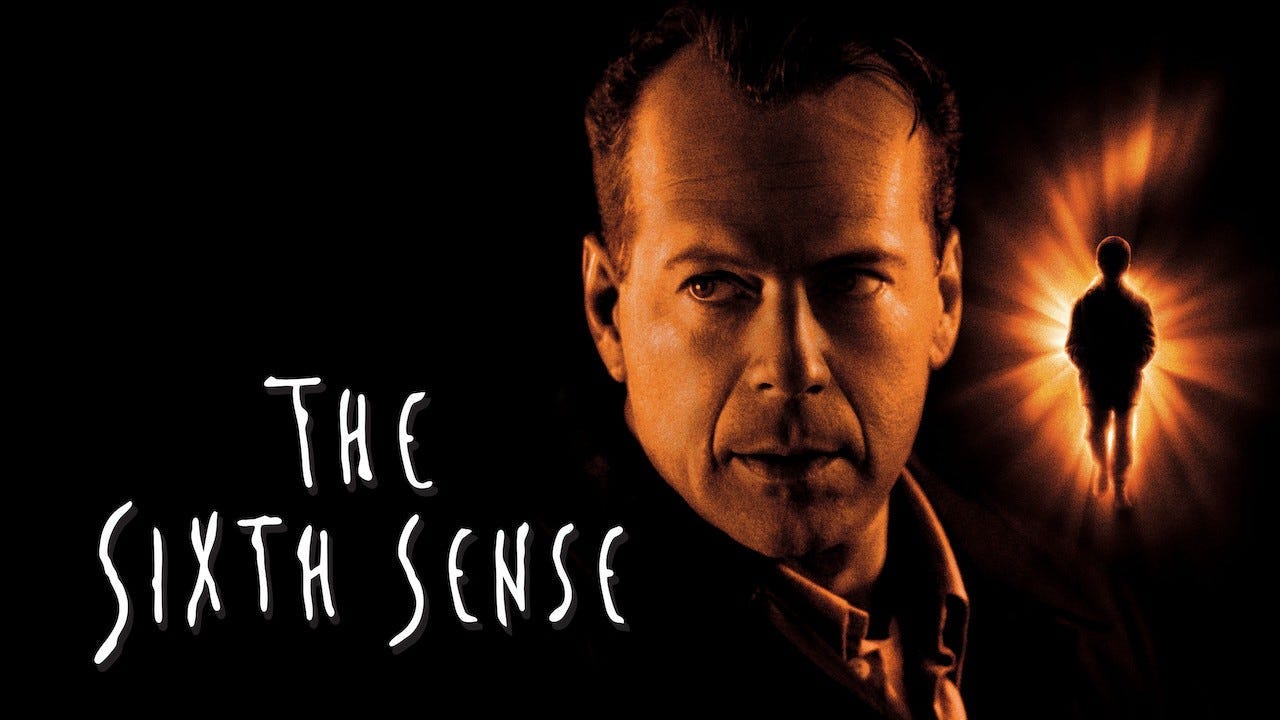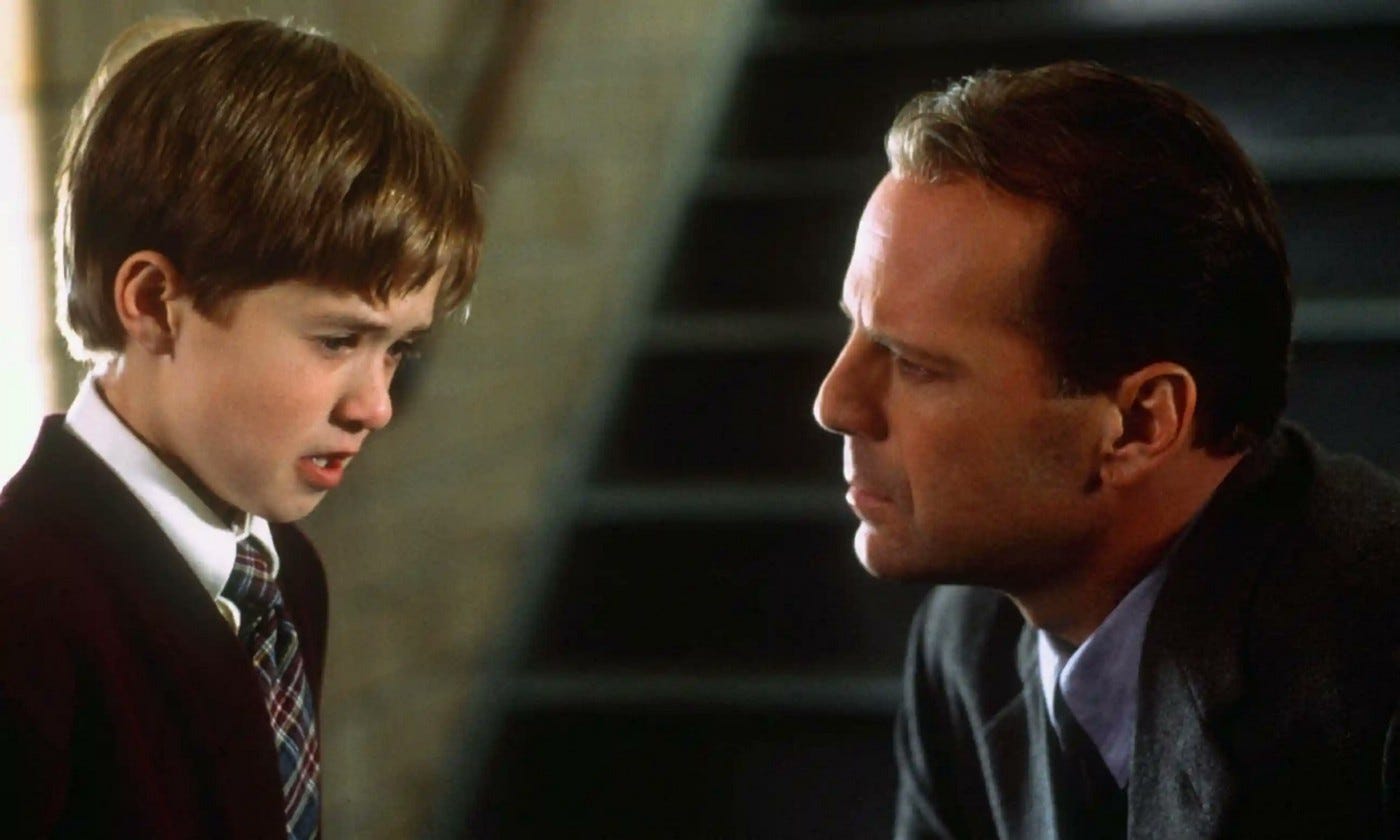What About 'The Sixth Sense's' Other Twist?
The famous climactic reveal about Bruce Willis’s character isn’t the film’s most important twist

Rewatching THE SIXTH SENSE— written and directed by M. Night Shyamalan — I was reminded yet again that we remember the wrong twist when we think about the film and why it works so well. Let’s discuss.
The twist you almost certainly think about when you do think about THE SIXTH SENSE is the climactic one (Bruce Willis’s therapist, Dr. Malcolm Crowe, is a ghost himself!), but there’s an earlier, more important twist far more critical to the film’s emotional resonance and ultimate success.
Here’s the thing: you probably don’t even consider it a twist today. Even if you saw THE SIXTH SENSE in 1999, you would’ve known about it before you saw the film, because the trailer just told you the kid with the weepy eyes (Haley Joel Osment) saw dead people right away.
The reason THE SIXTH SENSE’s trailer does this is practical — because to not reveal this twist would’ve left the studio no choice but to market the film as a moody, borderline gothic family drama with some psychological scares. That wasn’t going to get butts in the seats.
In this video, you can actually watch the scene as Shyamalan’s script is superimposed over the images.
Now, step back from how you remember THE SIXTH SENSE today and what you knew when you bought a ticket to see it for the first time. Try to consider THE SIXTH SENSE only as a screenplay, no heads-up about what you’re about to read.
“Ooh, what’s this? THE SIXTH SENSE by M. Night Shyamalan. Sounds super spooky.”
So, you crack it open, and for the next 54 PAGES, there is no talk of ghosts or the supernatural. None. What you instead get is a drama about a therapist, a damaged kid named Cole (which, incidentally, led to thousands of parents naming their kid Cole, ruining the uniqueness of my name — screw you, M. Night!), and the kid’s struggling mother (Toni Collette).

In those first 54 pages — which are spent almost entirely focused on character development and exploring the breakdown of communication in all its senses — you only get some open cupboards, a handprint on a metal tabletop, and some confusing muttering behind a wooden door. All of this could be explained by Cole’s mental health issues, which apparently include drawing dead bodies. A lot of dead bodies.
Meaning, THE SIXTH SENSE doesn’t present as a ghost story at all until its midpoint.
This is an important aspect of THE SIXTH SENSE. Every scene is constructed by Shyamalan to present you with one truth, which is what he wants you to see as part of his cinematic magic trick. (Even ghosts only see what they want to see in his film.)
Ask yourself: do you even remember that “I see dead people” isn’t uttered until THE SIXTH SENSE’s midpoint? Because this makes no narrative sense based on Hollywood precedent. That twist should be the Act 1 turn instead, which is the traditional place to state a film’s engine, which will go on to propel our protagonist/s through the rest of the story.
Consider how the conventional version of the film might have played out: Act 1 turn, “I see dead people”; Dr. Crowe and Cole then set out to help ghosts during what some writers call the “fun and games” section; then, at the midpoint, the narrative is flipped on its head when a shocking new danger (escalating stakes!) is revealed that might kill Cole’s mom or the therapist’s wife/widow. If Dr. Crowe and Cole don’t solve this supernatural mystery together — a mystery that will probably send them to the library to research who died in Dr. Crowe’s cellar or Cole’s building 100 years ago someone they love will die. Oh no!
But so much of the success of THE SIXTH SENSE comes from withholding the film’s most significant conceptual element — a kid sees dead people — until the midpoint.
This revelation is deftly dropped like a narrative bomb only after Dr. Crowe tells a story about how helping Cole will also fix his own trauma. Plot, theme, and character journey are so overtly stated here as to appear clunky, in fact, but then bam — “I see dead people.”
Now that’s what you call escalating of stakes! The therapist in this family drama, who thought he was on the verge of a breakthrough with a troubled kid — a kid who just announced he’s going to tell him his secret at last — suddenly realizes the kid might be beyond his help because…duh-duh-duh-duhhhhh…ghosts!
This twist — a twist to anyone reading THE SIXTH SENSE script for the first time — is far more dramatically and thematically important than the one that concludes the film. It shouldn’t work according to “screenwriting rules”…but it does. It’s funny how that works, isn’t it?
Rules are immensely valuable when constructing a story, but they can also be like shackles.
Imagine pitching something like this today, using, say, aliens:
“I want to write an alien visitation film…but we won’t mention or even reveal aliens are part of the story until halfway into it.”
“Get out of my office.”
“But — ”
“Out!”
“But we’re on Zoom.”
So what’s the takeaway here?
Audiences intuitively understand Hollywood screenwriting “rules” today. Think of these rules as conditioned responses based on years of filmgoing experience. This means you can use that to your advantage if you study and understand them enough to do so, as Shyamalan clearly did before writing THE SIXTH SENSE.
Read the script for THE SIXTH SENSE here.
If this article added anything to your life but you’re not up for a paid subscription, please consider buying me a “coffee” so I can keep as much of this newsletter free as possible for the dreamers who couldn’t afford it otherwise.
My debut novel PSALMS FOR THE END OF THE WORLD is out now from Headline Books, Hachette Australia, and more. You can order it here wherever you are in the world:






I've always thought the genius of this movie was that there were three moments of wrenching reveal: as you mention, when Malcolm realizes Cole is really seeing ghosts, when Malcolm realizes he is dead, but also when Cole's mother realizes what he has really been experiencing this whole time. That, to me, is the emotional core of the film, where the full impact of Cole's suffering hits home in the guilt-tinged emotional reaction of the great Toni Collette.
The most important line in that scene is when Cole explains not just that the ghosts don't know that they're dead, but that they can't SEE EACH OTHER — without this line, there's no movie.
It's there solely to explain why (in the fridge logic conversation after the movie) deceased Dr. Crowe doesn't see the ghosts that Cole sees (like in the school).
(This is my version of "the thing about The Sixth Sense that, so far as I know, nobody else has pointed out.)